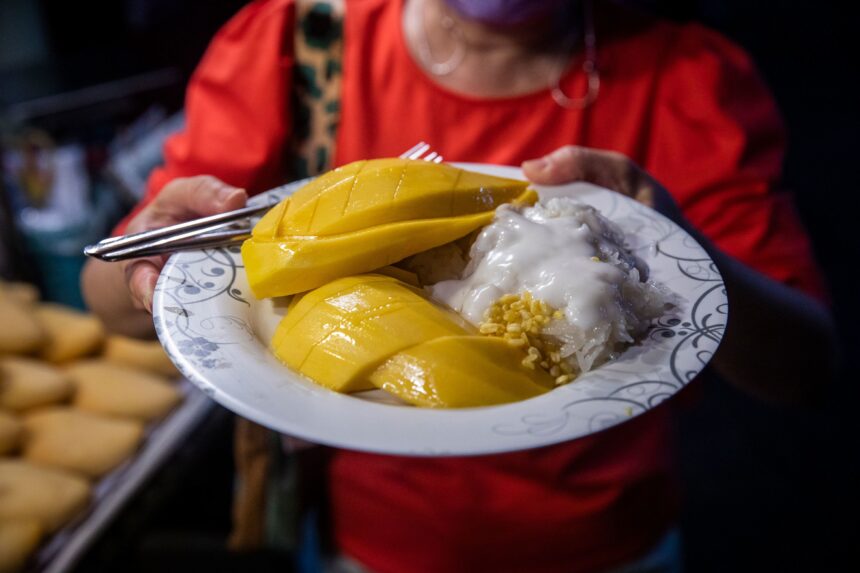In Chiang Rai, mango sticky rice is more than a sweet treat—it’s a vibrant local tradition. Picture glutinous rice tinted with butterfly pea flower, paired with juicy, honey-sweet mango, and a swirl of rich coconut cream. Every bite offers a mix of colour, aroma, and texture that feels like eating a summer afternoon.
Locals savour this dessert at festivals and night markets, turning an ordinary snack into a delightful cultural moment. If you find yourself wandering the streets of Chiang Rai, the scent of ripe mangoes and coconut milk draws you in, promising a sensory adventure you won’t soon forget.
The Story Behind Mango Sticky Rice: Chiang Rai’s Culinary Heritage
Mango sticky rice, known as “khao niew mamuang” in Thai, traces its roots to the rice paddies and fruit orchards of Northern Thailand. In Chiang Rai, people have given this dessert their touch, using indigenous ingredients as both flavour and art. The vivid blue hue sometimes seen in the rice comes from butterfly pea flower, a local bloom that tints food naturally.
Traditionally, sticky mango rice appears during family gatherings and celebrations, especially as mangoes reach their prime. Locals might enjoy it as a midday snack or serve it at temple fairs and festivals. Each region in Thailand adds its twist, but in Chiang Rai, the use of natural ingredients and craft preparation gives the dish an earthy charm.
Ingredients and Preparation Techniques
The essentials:
- Glutinous (sticky) rice: Soaked, then steamed to achieve that signature chew.
- Coconut milk: Sweetened and gently simmered before mixing with the rice.
- Fresh mango: Sliced thick, it must be ripe and fragrant.
- Butterfly pea flower: Used for vivid blue colour, steeped as a natural food dye.
Classic preparation combines hot sticky rice with warm coconut milk, letting it soak up every drop. Sometimes cooks sprinkle crisp mung beans on top for crunch. While tradition holds strong in Chiang Rai, trendy cafes and street stalls now play with new toppings or add scoops of coconut ice cream for extra indulgence, as seen at Connect Cafe.
Beneath the surface, it’s all about harmony—sweet, creamy, a touch of salt, soft rice meeting juicy mango. There’s magic in that mouthful.
Seasonality and Regional Influence
Mango sticky rice shines brightest from March to June, when local mangoes hit peak sweetness. Chiang Rai’s climate brings an abundance of Nam Dok Mai and Ok Rong varieties, prized for their perfume and taste. These short seasons mean the best versions can only be found when mangoes pile high in local markets.
Compared with Bangkok’s style, Chiang Rai often sticks to natural colouring and minimal fuss. The sticky rice itself might be earthier, less refined, highlighting regional rice varieties that tell a story of soil and tradition.
Where and How to Enjoy Sticky Mango Rice in Chiang Rai
Strolling through Chiang Rai after sunset, the scent of sticky rice and sweet mango leads your senses. Night markets, roadside carts, and cozy cafés all tempt with their takes on this classic dessert.
At night markets, plastic-wrapped bundles glow under fluorescent lights, while higher-end cafés plate up beautifully arranged servings with coconut ice cream on the side. Here, eating sticky mango rice is casual, sometimes messy, and always a source of smiles shared among friends.
Must-Visit Spots for Mango Sticky Rice
- Chiang Rai Night Bazaar: This bustling destination brings together local vendors in a vibrant setting. Look for carts serving sticky rice dyed blue with butterfly pea, paired with the juiciest mangoes. The bazaar is alive with chatter, live music, and the irresistible smell of fresh desserts.
- Connect Cafe: Famed for its modern take, Connect Cafe’s version of mango sticky rice comes with coconut ice cream and a photo-worthy presentation. Their reputation draws both locals and travellers, as seen in reviews and mouthwatering photos on sources like Tripadvisor.
- Akha Kitchen: A favourite known for using local ingredients from the surrounding hills. The setting is relaxed, and their take on sticky rice plays up the freshness factor.
Each of these spots reflects Chiang Rai’s spirit—welcoming, inventive, but rooted in tradition.
Tips for the Best Mango Sticky Rice Experience
- Visit in mango season: March to June guarantees ripe, flavorful fruit.
- Watch for local clues: The best versions are found where locals line up. If it looks too flashy and empty, it might be a tourist trap.
- Eat like a local: In easygoing settings, try using your hands for quick bites, or scoop up some sticky rice with a slice of mango for the perfect combo.
- Experiment with toppings: Some stalls invite you to pair your sticky rice with coconut ice cream, sesame seeds, or even extra coconut milk drizzled on top.
- Affordable treat: Most servings cost less than your daily coffee back home, so don’t shy away from trying more than one!
- Servings come in all sizes: Some vendors get creative with single-serve cup portions, while others pile it high, great for sharing at the table.
Get a feel for the energetic scene at the Chiang Rai Night Bazaar for a truly local experience. Or, if you prefer something quieter, cafés offer air-conditioning and a calm spot to watch the world go by.
Conclusion
Sampling mango sticky rice in Chiang Rai is a must for any traveller craving both tradition and flavour. Every bite connects you to the land, the farmers, and families that make sticky rice a local gem. From humble street stalls to creative café renditions, each plate celebrates Chiang Rai’s strong food culture and love of seasonal ingredients.
Make room for sticky mango rice on your Chiang Rai food adventure—you’ll come home with a sweet memory that lingers long after the last bite.














